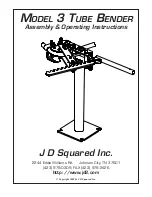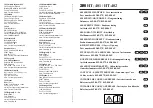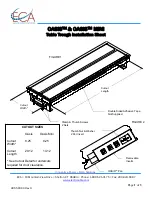
2023 Copyright Safewaze
4
Unless otherwise noted, Safewaze equipment is designed for use with Safewaze approved components and subsystems
only. Substitutions or replacements made with non-approved components or subsystems may jeopardize compatibility of
equipment and may affect safety and reliability of the complete system.
IMPORTANT:
Read and follow manufacturer’s instructions for associated components and subsystems
in your personal fall arrest system.
11.0 COMPATIBILITY OF COMPONENTS
When using this equipment, employers
must create a rescue plan, and provide the means to implement the plan.
This plan must be communicated to equipment users, authorized persons, and rescuers. Rescue operations require
specialized equipment beyond the scope of this manual. See ANSI Z359.4-2013 for specific rescue information.
9.0 INSPECTION FREQUENCY
10.0 RESCUE PLAN
Either the Authorized Person (User), or the Rescuer must inspect this equipment before each use. Annual inspections
must be completed by a Competent Person other than the user. Results must be documented.
From OSHA 1926.502 and 1910.66
Anchorages used for attachment of personal fall arrest systems shall be independent of any anchorage being used to
support or suspend platforms, and capable of supporting at least 5,000 lbs (22.2 kN) per user attached, or be designed,
installed, and used as part of a complete personal fall arrest systems which maintains a safety factor of at least two, and
is under the supervision of a qualified person.
Anchorages selected for fall arrest systems shall have a strength capable of sustaining static loads applied in the
directions permitted by the system of at least:
1.
5,000 lbs. (22.2 kN) for non-certified anchorages, or
2.
Two times the maximum arresting force for certified anchorages.
When more than one fall arrest system is attached to an anchorage, the strengths set forth in (1) and (2) above shall be
multiplied by the number of systems attached to the anchorage.
Connectors are compatible with connecting elements when they have been designed to work together in such a way
that their sizes and shapes do not cause their gate mechanisms to inadvertently open regardless of how they become
oriented. Connectors (hooks, carabiners, and D-rings) must be capable of supporting at least 5,000 lbs. (22.2 kN). Do
not use equipment that is not compatible. Non-compatible connectors may unintentionally disengage (See Figure 3).
Connectors must be compatible with the anchorage or other system components (See Figure 4). Connectors must be
compatible in size, shape, and strength. Self-locking snap hooks and carabiners are required by ANSI Z359 and OSHA
guidelines. Contact Safewaze if you have any questions about compatibility.
12.0 COMPATIBILITY OF CONNECTORS
NOTE:
SOME SPECIALTY CONNECTORS HAVE ADDITIONAL REQUIREMENTS. CONTACT
SAFEWAZE WITH QUESTIONS.
FIGURE 3 - UNINTENTIONAL DISENGAGEMENT
3 - gate opens
2 - gate presses
against
non-complaint part
4 - parts disengage
1 -
Non-compliant part
Using a connector that is undersized or irregular in shape (1) to connect a snap hook or carabiner could allow the
connector to force open the gate of the snap hook or carabiner. When force is applied, the gate of the hook or carabiner
presses against the non-compliant part (2) and forces open the gate (3). This allows the snap hook or carabiner to
disengage (4) from the connection point.


































